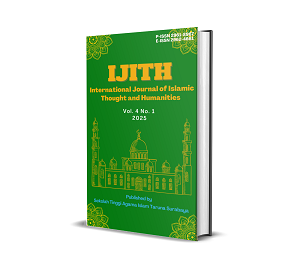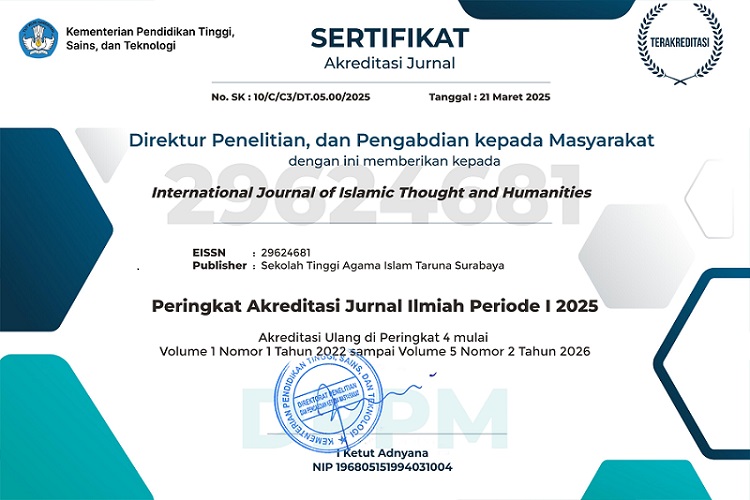Making Keychain Crafts with Asmaul Husna Writing from Wire Feathers: Islamic Art Expression at Elshaddai Studio Klang Kuala Lumpur Malaysia
DOI:
https://doi.org/10.54298/ijith.v4i1.379Keywords:
Handicrafts, Migrant Children, Asmaul HusnaAbstract
This research examines Indonesian children's training in making feather wire keychain crafts with Asmaul Husna inscriptions at Elshaddai Studio, Klang, Kuala Lumpur, Malaysia. The research also wanted to explore the Islamic meanings and values contained in the work and its impact on the religious understanding and creativity of migrant children. The research method used is a qualitative approach with a case study type, which allows researchers to explore the phenomenon of handicraft skills applied in the social, cultural, and spiritual context of the Indonesian migrant children's community. Data was collected through observation, interview, and documentation techniques. The results showed that the training provided practical skills to the children and introduced them to the values of tawhid and the beauty of Islam through Asmaul Husna. In addition, this training can increase children's self-confidence and provide them with valuable skills in daily life. This keychain craft also has a spiritual function as a reminder of the names of Allah. It could be an effective medium of da'wah to introduce Islamic teachings to the broader community. Thus, this research contributes to Islamic arts-based education among migrant children and introduces the potential of a creative economy through handicrafts.
Downloads
References
Agustina, W., Hulu, A., Dwi, L., & Situngkir, M. (2024). Pelatihan pembuatan boneka tangan dalam pengembangan sikap toleransi dan keberagaman di desa sipahutar. Community Development Journal, 5(1), 1108–1114.
Arfanaldy, S. R., & Pamuncak, M. B. (2025). The Urgency of Multicultural Education in Building a Civil Society : The Perspective of Islamic Educational Philosophy. International Journal of Islamic Thought and Humanities, 4(1), 117–129.
Asy-Syarofi, A. F, et al. (2024). Pemberdayaan Ekonomi Ibu-Ibu PKK : Kerajinan Bunga Dari Kawat. Gudang Jurnal Multidisiplin Ilmu, 2(September), 38–42.
Cokki, C., & Ocberta, N. (2024). Praktik Mindfulness pada Dewasa Awal Menggunakan Gantungan Kunci “ Mindkey ” Praktik Mindfulness pada Dewasa Awal Menggunakan Gantungan Kunci. Jurnal Sosial Humaniora Terapan, 7(1), 53–61. https://doi.org/10.7454/jsht.v7i1.1140
Crisdian, H. A., Prawistyasari, A., Kesehatan, F. I., Kusuma, U., Surakarta, H., Farmasi, F., & Budi, U. S. (2023). Pelatihan pipe cleaner creation sebagai upaya peningkatan keterampilan ibu-ibu dharma wanita MAN 3 jember. Abdimas Siliwangi, 6(1), 83–89. https://doi.org/10.22460/as.v7i2.23060
Erzen, J. N. (2007). Islamic aesthetics: An alternative way to knowledge. The Journal of Aesthetics and Art Criticism, 65(1), 69–75.
Evalina, N., Abduh, R., & Arfis, A. (2019). Pembuatan Gantungan Kunci Dari Bahan Resin di Desa Jaharun A. Prosiding Seminar Nasional Kewirausahaan, 1(1), 251–256.
Fuady, F. (2022). Nilai Etika dalam Seni Islam: Studi Pemikiran Seyyed Hossein Nasr. Jurnal Peradaban, 2(2).
Hakim, A. R, et al. (2024). Peningkatan Kualitas SDM melalui Pelatihan Pembuatan Buket Bunga dalam Upaya Meningkatkan Kesejahteraan Masyarakat. IPM : Jurnal Inovasi Pengabdian Masyarakat, 1(2), 39–45.
I’tibar, M, et al. (2024). Workshop Kerajinan Kawat Bulu sebagai Alternatif Usaha. Berdesa : Jurnal Pengabdian Masyarakat, 01, 74–82. https://doi.org/10.47431/bds.v1i2.498
Ismail, A., & Arnez, G. (2024). Meningkatkan Keterampilan Membuat Gantungan Kunci Melalui Strategi Joy Learning Pada Siswa Tunagrahita. Jurnal Penelitian Pendidikan Kebutuhan Khusus, 12, 158–162.
Ismail, R., & Zakaria, D. A. (2022). Mujarad as a Manifestation of Oneness of God (tawheed) in the Modern Islamic Art of Malaysia and Indonesia. Jati-journal of southeast asian studies, 27(2), 101–126.
Izza, G., Milla, H., Wathani, M. F., Asiroh, N. H., Ahmad, I. M., Tafsir, A., Guru, P., Ibtidaiyah, M., Tafsir, I. A., Fakultas, D., & Kesehatan, P. (2025). Pengembangan Kreativitas Melalui Pelatihan Buket Kawat Bulu Untuk Siswa Kelas 6 SD Negeri Sumurboto. Gudang Jurnal Pengabdian Masyarakat, 3, 1–6.
Mehilda, S., Ishak, K., Selamat, M. I., & Batubara, Z. (2024). Pelatihan Ekonomi Kreatif Melalui Kerajinan Buket Bunga di Rumah Anak Yatim Darul Aitam, Kampung Bukit Pegoh Pernu Melaka, Malaysia. JGEN : Jurnal Pengabdian Kepada Masyarakat, 2(1), 449–457.
Mutiara, S., Nurlaila, S., & Azima, M. F. (2021). Pelatihan Pembuatan Kerajinan Tangan Dari Barang Bekas Pada Ibu-Ibu Pengajian Desa Danau Kabupaten Pringsewu. Kumawula: Jurnal Pengabdian Kepada Masyarakat, 4(2), 308. https://doi.org/10.24198/kumawula.v4i2.33898
Nopianti, H., Himawati, I. P., & Arwani, M. (2021). Pelatihan Kerajinan Tembaga Bagi Perempuan Pesisir Di Desa Malabero Kecamatan Teluk Segara Kota Bengkulu. Seminar Nasional Pengabdian Masyarakat LPPM UMJ, 1–8.
Prayogi, R., Tanjung, M. R., Agustin, F., Salsabila, D. V., Utama, U. P., Jl, A., Yos, K. L., Km, S., Mulia, T., Mulia, T., Deli, K. M., Medan, K., & Utara, S. (2025). Pelatihan Membuat Kerajinan Tangan Aksesoris Dari Manik-Manik Untuk Meningkatkan Inovasi-Creativepreneurship Pada Masyarakat Training on Making Handicraft Accessories from Beads to Increase Innovation-Creativepreneurship at Public Desain Komunikasi Visual. Ekspresi: Publikasi Kegiatan Pengabdian Indonesia, 2(1), 12–20.
Radzaky, D. R, et al. (2025). Pengembangan Keterampilan dan Pengetahuan Sumber Daya Manusia Kelompok PKK dalam Mendukung Industri Kreatif di Daerah Pedesaan. Prima Abdika: Jurnal Pengabdian Masyarakat, 5636(1), 16–29.
Robbaney, M. I. (2024). Workshop dan Pelatihan Kerajinan Buket guna Membangun Wirausahawan Ibu-Ibu PKK Desa Srondol Kulon Workshop and Training on Bouquet Crafts to Build Entrepreneurs of PKK Mothers in Srondol Kulon Village. Transformasi Masyarakat: Jurnal Inovasi Dan Sosial Pengabdian, 1(4), 74–81.
Rohmad, M. A. (2020). The Role of Islamic Art in Enhancing the Spirituality of the Indonesian Young Generation. Teosofia: Indonesian Journal of Islamic Mysticism, 9(1), 63–74.
Saeed, K. M. (2011). Islamic art and its spiritual message. International Journal of Humanities and Social Science, 1(2), 227–234.
Setiawati, E., Setiawati, E., Rachman, M., Widya, U., & Mahakam, G. (2022). Pelatihan Membuat Kerajinan Tangan Dari Kain Flanel Sebagai Ide Kewirausahaan Bagi Ibu-Ibu Dasawisma Mugirejo. Jurnal Pengabdian Kreativitas Pendidikan Mahakam (JPKPM), 2(2), 314–318.
Sulaiman. (2021). Art: The Spiritual Path to God. Jurnal Theologia, 32(2), 307–326. https://doi.org/https://doi.org/10.21580/teo.2021.32.2.25034
Syafi’i, A. G., & Masbukin, M. (2022). KALIGRAFI DAN PERADABAN ISLAM Sejarah dan Pengaruhnya bagi Kebudayaan Islam di Nusantara. Nusantara; Journal for Southeast Asian Islamic Studies, 17(2), 68. https://doi.org/10.24014/nusantara.v17i2.16300
Tauran, A., Gemenop, J., Wattimena, L. N., & Lahallo, F. F. (2024). Pelatihan Pembuatan Produk Hiasan Buah Merah Dari Kawat Buluh Pada Remaja Kompleks Malanu , Kota Sorong. Marsipature Hutanabe: Jurnal Pengabdian Kepada Masyarakat, 1(02), 54–60.
Zahra, F., & Shahir, S. Bin. (2022). The Spiritual Aesthetics of Islamic Ornamentation and the Aesthetic Value in Islamic Architecture. Journal of Islamic Thought and Civilization, 12(1), 116–128.
Downloads
Published
How to Cite
Issue
Section
License
Copyright (c) 2025 Nurul Hasanah, Lia Ariska Ritonga

This work is licensed under a Creative Commons Attribution-ShareAlike 4.0 International License.
Authors who publish with this journal agree to the following terms:
- Authors retain copyright and grant the journal right of first publication with the work simultaneously licensed under a Creative Commons Attribution-ShareAlike 4.0 that allows others to share the work with an acknowledgement of the work's authorship and initial publication in this journal.
- Authors are able to enter into separate, additional contractual arrangements for the non-exclusive distribution of the journal's published version of the work (e.g., post it to an institutional repository or publish it in a book), with an acknowledgement of its initial publication in this journal.
- Authors are permitted and encouraged to post their work online (e.g., in institutional repositories or on their website) prior to and during the submission process, as it can lead to productive exchanges, as well as earlier and greater citation of published work (See The Effect of Open Access).


















